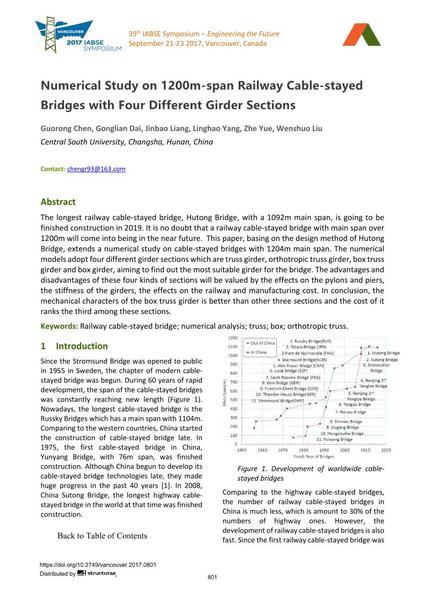Numerical Study on 1200m-span Railway Cable-stayed Bridges with Four Different Girder Sections

|
|
|||||||||||
Bibliographic Details
| Author(s): |
Guorong Chen
(Central South University, Changsha, Hunan, China)
Gonglian Dai (Central South University, Changsha, Hunan, China) Jinbao Liang (Central South University, Changsha, Hunan, China) Linghao Yang (Central South University, Changsha, Hunan, China) Zhe Yue (Central South University, Changsha, Hunan, China) Wenshuo Liu (Central South University, Changsha, Hunan, China) |
||||
|---|---|---|---|---|---|
| Medium: | conference paper | ||||
| Language(s): | English | ||||
| Conference: | IABSE Symposium: Engineering the Future, Vancouver, Canada, 21-23 September 2017 | ||||
| Published in: | IABSE Symposium Vancouver 2017 | ||||
|
|||||
| Page(s): | 801-808 | ||||
| Total no. of pages: | 8 | ||||
| Year: | 2017 | ||||
| DOI: | 10.2749/vancouver.2017.0801 | ||||
| Abstract: |
The longest railway cable-stayed bridge, Hutong Bridge, with a 1092m main span, is going to be finished construction in 2019. It is no doubt that a railway cable-stayed bridge with main span over 1200m will come into being in the near future. This paper, basing on the design method of Hutong Bridge, extends a numerical study on cable-stayed bridges with 1204m main span. The numerical models adopt four different girder sections which are truss girder, orthotropic truss girder, box truss girder and box girder, aiming to find out the most suitable girder for the bridge. The advantages and disadvantages of these four kinds of sections will be valued by the effects on the pylons and piers, the stiffness of the girders, the effects on the railway and manufacturing cost. In conclusion, the mechanical characters of the box truss girder is better than other three sections and the cost of it ranks the third among these sections. |
||||
| Keywords: |
truss numerical analysis cable-stayed railroad bridge box orthotropic truss
|
||||

